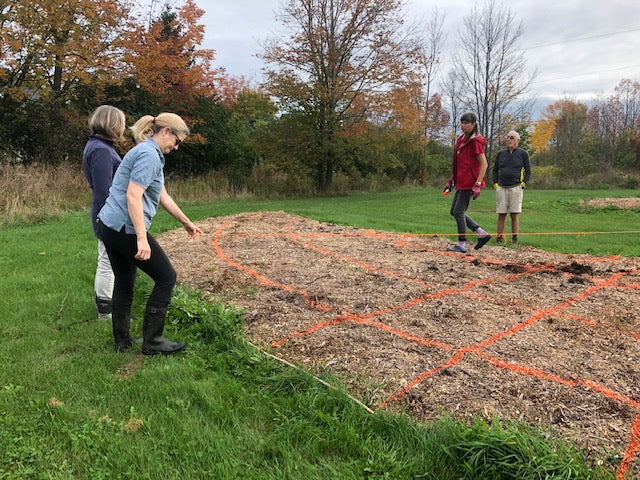Wolfe Island, Ontario is the first and the largest of the 1000 Islands, situated at the east end of Lake Ontario and the mouth of the St, Lawrence River. The population is approximately 1500 in winter which more than doubles in the summer.
Our design principles
- Cultivate relationships: By sharing our stories and shovels, our laughter and harvests, our gifts and our needs, we build relationships and weave community
- Serve as a learning lab: By following our curiosity, expanding our senses we can become a creative force for positive change
- Tune into the land: Plants aren't isolated entities, but participants in a system constantly in flux. Practising intergenerational and multispecies seeing, sensing, and learning
- Grow resilience: By listening to, learning from, and adapting to the natural world we can strengthen the ecological web to which we belong
- Feed our spirits: along with the seeds we plant, we cultivate natural spaces that feed our spirits and strengthen our connection to and love for the land
- Strengthen community: grow connection and invite inclusiveness among a diversity of beings - people, plants, insects, microbes, birds, and animals
About the space
- Municipally owned Community Centre grounds that includes ball diamond, ice rink, change house and space for public events
- Neighbour to Marysville Public School (K-8) and United Church
- A Little Forest answers many of the needs of the school community: reconciliation with Indigenous peoples and with the Land and Nature; science on the land; outdoor classroom post pandemic
- This will be the only area for shade as the trees grow. It is east of the welcome gate and has already become a meeting place where none existed before
- 100 square metres, the modified yin yang design of the 2 halves separate in the middle to welcome and embrace those visitors to come and sit. This space will also serve as an outdoor classroom
Why we planted a Little Forest
- Wolfe Island has lost a great number of trees from its original forested state as it changed into an agricultural area. Further, many storms and disease pressures have reduced tree cover in recent years. While many private landowners have engaged in large tree planting initiatives in the last 15 years, these are largely monocultures and include non-native species
- Engaging all citizens would strengthen our community
- To learn about the species Indigenous to this land
- To grow our capacity to steward the land
- Becomes a nature-based solution to the biodiversity and climate crises
- We're combining what we’re learning about rapid natural forest regeneration from Western science with teachings from Traditional Ecological Knowledge (TEK) on how to transform our relationship with trees and with the land.
How We Started
- A formal request was made in winter 2021 by a site champion to Town Council to approve the plan and provide funding. Forty percent was offered for the project. The remaining cost was covered through wider community fundraising
- Site champion was already a member of a citizens community group - Frontenac Islands Residents for the Environment (FIRE). Using this network, it began with a call for support and then to the wider community: labour, and supplies were donated. Indigenous leader volunteered to host an opening ceremony to acknowledge the land given for growing the Little Forest and also the people who will share together in its growth. Children and adults came together to voice their wishes for the Little Forest.
- Regular community volunteers became the backbone of the Little Forest. These came out for the periodic scheduled work bees. This was initially organised through a greater community wide survey
- Brought in the public school and all grades helped with planting. There is strong interest in bringing the activities of the Little Forest into the curriculum. A soil prep class was given to grades 4-8
Our stewardship plan
- Soil testing was done in July which helped to inform a maintenance plan. Sandy loam soil requires less deep but more frequent watering than clay soil, for example. Having a soil test done in year one and then again in year 3 will help show if our method of soil prep has resulted in the desired outcome of improving the soil to support trees. Overall, soil testing shouldn’t be required unless there is question of the land’s history
- Just before bud break in spring the recycled plastic tree guards are removed and deer repellant spray, Bobbex, was applied. Marker flags will be kept in place until the trees are very visible (2 years). The first winter, these flags supported the tree guards
- Deer/rabbit repellent spray is done at a minimum of monthly - it must be applied more often while leaf growth increases
- End of June/July, invasive plants and unwanted weeds will be removed
- Water needs will be assessed based on weather conditions. The township will provide a water truck for this
- Tree guards need to be applied after the ground freezes in the fall in year 2 and 3
- This cycle will be in place for the first 3 years at which time the Little Forest is well under way
Preparing the soil
- The Little Forest site has been regularly mowed lawn for many years. The site has had cars parked for events during spring/summer/fall. Soil texture test, compaction, and drainage tests revealed that sandy loam is about 10 - 30 cm deep with some bedrock present
- A no-dig method of soil preparation was chosen, offering the soil microbiology an abundance of organic matter to help aerate the soil and shift from bacterial to fungal dominance
- First layer in June was 4 bales old hay rolled out to a depth of 7- 10 cm
- Followed by 3 cm of 6 month aged organic cow manure
- Finalised by a 7 - 10 cm of fresh and composted wood chips. This also provides long term mulch and will not be needed to be applied again
- At planting time, a handful of healthy forest soil was placed in each planting hole along with 1 mL of Root Rescue mycorrhizal fungi inoculum
- Lesson learned: It would have been better to start in May to hasten decomposition as some hay was still intact
Species selection
Source: Deciduous Forest Ecozone Ecological Land Classification for Southern Ontario
- Wolfe Island is Ecoregion 6E Temperate hardwood forest. The Miyawaki method % refers to overall number, not number of species
- Ideal layer ranges are: Canopy 20%, Tree 40-50%, Subtree 25-30%, Shrub 8-12%
- Of that mix can see up to 25% evergreen – based on local forester consultant
- Five dominant species: In the Miyawaki method, 5 species as the dominant forest species are chosen, each forming 8% of the total seedlings. Our selection was Bur Oak, Quercus macrocarpa, White Birch, Betula papyrifera, Black Cherry, Prunus Serotina, Chokecherry, Prunus virginiana, all at 7% and Shagbark Hickory, Carya ovata, at 8%
- Size: 100 square metres
- Density: 3 saplings/m2
- Saplings: 300
- Species: 43
- Lesson learned is that we should have achieved 8% for all 5 species. Also, 10 m between the 2 halves of the planting area were too far apart according to the methodology, which recommends no more than 3 m
Advice to other communities looking to build a little forest
- Photo - Mayor Doyle and Howe Island Site Champion for Little Forest in 2022
- Get necessary approvals from the land owners and users and have a fundraising strategy
- engage interested students especially Indigenous students through a club, have students ‘market’ the Little Forest in the school and beyond
- communicate the interdisciplinary active nature of a Little Forest at your local school(s); frame it as a ‘good ancestor’ activity, a legacy project with long term beneficial effects for the school, community and ‘all our relations’ that takes us past teaching and learning about climate change and biodiversity crisis into action
- enlist the support of neighbours to the school
- develop a group of outside knowledge holders to help, look at the local Master Gardeners, Conservation Authority and any other groups that may be able to guide the process
- Seek out farmers, arborists, composting facilities, which may be needed for the supplies in soil prep

